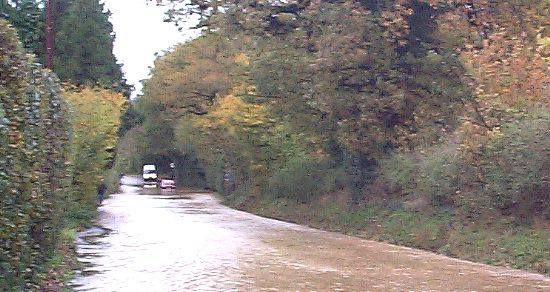| Tickners Bridge
You may be forgiven for not knowing where "Tickners Bridge"
is as it is now reduced to a mere culvert under the Guildford Road in Normandy
but it was once a vital link between the village and the outside world.
It is situated about two hundred yards west of our only pub, The Duke of
Normandy.

- Flood at Tickners Bridge, 30th October 2000
The water which flows through the culvert is formed by the confluence
of two streams, one of which rises in the vicinity of Catherine Frith and
the other, which itself is composed of two streams, rising respectively
in Wanborough and East Flexford. The combined stream passes into Henley
Park and eventually falls into the River Thames via the Stanford Brook,
Hoe Stream and the River Wey.
The stream was important in bygone days as it formed part of the boundary
between the parishes of Ash and Worplesdon. (Normandy was part of Ash parish
at that time.) The beating of the bounds was a regular event and in 1562
a document stated "Beginning at Cleygate Hill northwards by the hedge
of lands called French Inghams ...Pytridge Lane ... comes unto Tickners
Bridge and so northwards unto Henley Park as ye brook or stream doth lead
upon the north part until it cometh unto Cobetts Bridge…..".
Another document dating from the second half of the 17th century relates
John Kerr's oath at Serjeants Inn, London before Judge Thurland that "56
years since he went the bounds of Worplesdon parish and that they always
went along the south side of the brook in Henley Park from Tickners Bridge
to Cobetts Bridge with the Ministers and parishioners of Worplesdon and
the Ashe inhabitants used to go the other side of the brook."
The bridge is situated at almost the lowest part of the parish and the
area was subject to frequent flooding up until comparatively recent times.
There was probably a causeway leading up to the bridge on either side.
A measure of the importance of the bridge may be gathered from the frequent
complaints about the state of its repair recorded in the Court records
of the Manor of Cleygate. The upkeep was the responsibility of the Lord
of the Manor rather than the tenants and in 1546 it is recorded that "A
certain common bridge called Tyttnersh Bridge is ruinous and very much
in decay to the common hindrance that the Lord of this Manor ought to amend
the said bridge..." Again, in 1555 "A certain bridge called Tytners
Bridge is very perilous and in decay for lack of plonk (sic) in default
of the King and Queen's Majesties. Therefore they pray the said King and
Queen of their Grace to amend the bridge aforesaid." At this time
the Lords of the Manor were Mary Tudor and her husband Philip II of Spain.
Perhaps she was too busy burning heretics and he appeared to take little
interest in his English Domain.
So it went on until Local Government was revolutionized in the 19th
century and the upkeep of the roads and their appurtenances became the
responsibility of the County Councils. So next time you travel between
Normandy and Guildford spare a thought for our forebears and their troubles.
Perhaps a few pot holes in the road will not seem so serious. Jack Kinder |